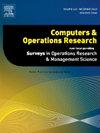Multi-door cross-dock scheduling under flexible doors mode and material handling resource restrictions
IF 4.1
2区 工程技术
Q2 COMPUTER SCIENCE, INTERDISCIPLINARY APPLICATIONS
引用次数: 0
Abstract
Cross-docks are used in distribution networks to improve efficiency by minimizing the need for warehouse space and optimizing the supply chain. Cross-docks are primarily implemented for consolidating less-than-truckload shipments to realize gains from economies of scale in transportation. This is accomplished by scheduling inbound truck arrivals to the strip doors where their freight is either moved directly to outbound trucks parked at the stack doors or held for a very short time waiting for the assigned outbound truck to arrive. This research focuses on two important operating dimensions of cross-docks. The first is the decision to preassign each door in the cross-dock to either be used for strip or stack operations exclusively (separate door operations) or dynamically assign doors for strip or stack operations as needed (mixed door operations). The second examines assigning material handling devices (e.g., forklifts) to various tasks to make the cross-dock operate efficiently and achieve the required high throughput. A mathematical programming model of mixed door operation is developed and compared with a separate doors model that exists in the literature. A second mathematical programming model is presented that has finite material handling capacity and explicitly models the unloading and loading tasks. To improve computation times, a convex hull formulation of the separate-door model is developed and compared with the widely used Big-M method. Simulated annealing based algorithms are developed to solve cross-dock problems for medium to largescale instances. An integrated simulated annealing algorithm decodes a genotypic representation for the restricted material handling model’s solution to assign doors and forklifts to trucks simultaneously via a series of operating rules. Simulated annealing is used to improve the resultant forklift assignments from the integrated method to produce an upper bound for the limited material handling problem. Numerical results provide important insights into improved delivery times associated with using a mixed door strategy in certain situations. Additionally, results indicate transition points exist that allow decision makers to determine the minimum number of forklifts required for various cross-dock sizes to avoid bottleneck delays.
柔性门模式和物料搬运资源限制下的多门交叉码头调度
在分销网络中使用交叉码头,通过最大限度地减少对仓库空间的需求和优化供应链来提高效率。交叉码头主要用于整合少于卡车的货物,以实现运输规模经济的收益。这是通过安排进站卡车到达条形门来完成的,在条形门上,它们的货物要么直接转移到停在堆垛门上的出站卡车上,要么在很短的时间内等待指定的出站卡车到达。本研究的重点是两个重要的跨码头经营维度。首先是决定预先分配交叉船坞中的每个门,以便专门用于剥离或堆叠操作(单独的门操作),或者根据需要动态分配门用于剥离或堆叠操作(混合门操作)。第二项检查分配物料搬运设备(例如叉车)执行各种任务,以使交叉码头高效运行并实现所需的高吞吐量。建立了混合门运行的数学规划模型,并与已有的分门运行模型进行了比较。提出了具有有限搬运能力的第二种数学规划模型,并对装卸任务进行了明确的建模。为了缩短计算时间,提出了一种独立门模型的凸壳公式,并与广泛使用的Big-M方法进行了比较。基于模拟退火的算法被开发用于解决中大型实例的交叉码头问题。集成模拟退火算法解码受限物料搬运模型解的基因型表示,通过一系列操作规则将门和叉车同时分配给卡车。利用模拟退火的方法对综合方法得到的叉车分配进行改进,得到有限物料搬运问题的上界。数值结果为在某些情况下使用混合门策略改善交货时间提供了重要的见解。此外,结果表明存在过渡点,使决策者能够确定各种交叉码头规模所需的最小叉车数量,以避免瓶颈延迟。
本文章由计算机程序翻译,如有差异,请以英文原文为准。
求助全文
约1分钟内获得全文
求助全文
来源期刊

Computers & Operations Research
工程技术-工程:工业
CiteScore
8.60
自引率
8.70%
发文量
292
审稿时长
8.5 months
期刊介绍:
Operations research and computers meet in a large number of scientific fields, many of which are of vital current concern to our troubled society. These include, among others, ecology, transportation, safety, reliability, urban planning, economics, inventory control, investment strategy and logistics (including reverse logistics). Computers & Operations Research provides an international forum for the application of computers and operations research techniques to problems in these and related fields.
 求助内容:
求助内容: 应助结果提醒方式:
应助结果提醒方式:


